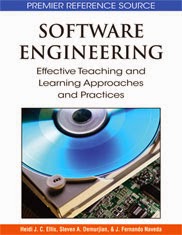Software Engineering Effective Teaching and Learning Approaches and Practices
Buku Ini diterbitkan tahun 2009 oleh : Information science reference, New York.
Judul: Software Engineering Effective Teaching and Learning Approaches and Practices
Oleh: Heidi J. C. Ellis, et al
Penerbit: Information science reference, New York
Tahun: 2009
Jumlah Halaman: 433 hal.
Penulis:
Heidi J. C. Ellis
Trinity College, USA
Steven A. Demurjian
University of Connecticut, USA
J. Fernando Naveda
Rochester Institute of Technology, USA
Hershey • New York
Lingkup Pembahasan:
Buku ini sangat berguna bagi akademisi dan praktisi. Pembaca akademik akan memperoleh pemahaman praktek terbukti telah digunakan dalam rekayasa pendidikan perangkat lunak yang dapat digunakan pada lembaga mereka. Pembaca industri akan mendapatkan keuntungan dari pemahaman tentang sinergi antara pendidikan praktek dan pengembangan perangkat lunak dunia nyata. Semua pembaca akan memperoleh pandangan reknik software pendidikan internasional. Pendidik dapat menggunakan buku sebagai referensi untuk mengadopsi teknik pengajaran baru dan untuk meningkatkan pengajaran mereka digunakan berbagai program komputasi.
Buku ini disusun dalam tujuh bagian yang mencakup belajar siswa dan penilaian, inovatif
metode pengajaran, rekayasa perangkat lunak berbasis proyek, teknologi pendidikan, kurikulum dan pendidikan manajemen, dan praktek profesional.
Daftar Isi:
Foreword xv
Preface xvii
Acknowledgment xxv
Section I Introduction
Chapter I Software Engineering Education: Past, Present, and Future 1
Gregory W. Hislop, Drexel University, USA
Section II Student Learning and Assessment
Chapter II Constructive Alignment in SE Education: Aligning to What? 15
Jocelyn Armarego, Murdoch University, Western Australia
Chapter III On the Role of Learning Theories in Furthering Software Engineering
Education 38
Emily Oh Navarro, University of California, Irvine, USA
André van der Hoek, University of California, Irvine, USA
Section III Innovative Teaching Methods
Chapter IV Tasks in Software Engineering Education: The Case of a Human Aspects of
Software
Engineering Course 61
Orit Hazzan, Technion - IIT, Israel, Jim Tomayko, Carnegie Mellon University, USA
Chapter V Speaking of Software: Case Studies in Software Communication 75
Ann Brady, Michigan Technological University, USA
Marika Seigel, Michigan Technological University, USA
Thomas Vosecky, Michigan Technological University, USA
Charles Wallace, Michigan Technological University, USA
Chapter VI Novel Methods of Incorporating Security Requirements Engineering into Software
Engineering Courses and Curricula 98
Nancy R. Mead, Software Engineering Institute, USA
Dan Shoemaker, University of Detroit Mercy, USA
Section IV Project-Based Software Engineering
Chapter VII The Software Enterprise: Preparing Industry-Ready Software Engineers. 115
Kevin A. Gary, Arizona State University, USA
Chapter VIII Teaching Software Engineering in a Computer Science Program Using the Affinity
Research Group Philosophy 136
Steve Roach, The University of Texas at El Paso, USA
Ann Q. Gates, The University of Texas at El Paso, USA
Chapter IX A Framework for Success in Real Projects for Real Clients Course 157
David Klappholz, Stevens Institute of Technology, USA
Vicki L. Almstrum, The University of Texas at Austin, USA
Ken Modesit, Indiana University – Purdue University Ft. Wayne, USA
Cherry Owen, The University of Texas of the Permian Basin, USA
Allen Johnson, Huston-Tillotson University, USA
Steven J. Condly, HSA Learning & Performance Solutions, USA
Chapter X Experiences in Project-Based Software Engineering: What Works, What
Doesn’t 191
Steven A. Demurjian, University of Connecticut, USA
Donald M. Needham, United States Naval Academy, USA
Section V Educational Technology
Chapter XI Applying Blended Learning in an Industrial Context: An Experience Report . 213
Christian Bunse, International University in Germany, Germany
Christian Peper, Fraunhofer Institute Experimental Software Engineering, Germany
Ines Grützner, Fraunhofer Institute Experimental Software Engineering, Germany
Silke Steinbach-Nordmann, Fraunhofer Institute Experimental Software Engineering,
Germany
Chapter XII Integrated Software Testing Learning Environment for Training Senior-Level
Computer Science Students 233
Daniel Bolanos, Universidad Autonoma de Madrid, Spain
Almudena Sierra, Universidad Rey Juan Carlos, Spain
Section VI Curriculum and Education Management
Chapter XIII Software Engineering Accreditation in the United States 251
James McDonald, Monmouth University, USA
Mark J. Sebern, Milwaukee School of Engineering, USA
James R. Vallino, Rochester Institute of Technology, USA
Chapter XIV Software Engineering at Full Scale: A Unique Curriculum. 265
Jochen Ludewig, Universität Stuttgart, Germany
Chapter XV Continuous Curriculum Restructuring in a Graduate Software Engineering
Program 278
Daniela Rosca, Monmouth University, USA
William Tepfenhart, Monmouth University, USA
Jiacun Wang, Monmouth University, USA
Allen Milewski, Monmouth University, USA
Chapter XVI How to Create a Credible Software Engineering Bachelor’s Program: Navigating
the Waters of Program Development 298
Stephen Frezza, Gannon University, USA
Mei-Huei Tang, Gannon University, USA
Barry J. Brinkman, Gannon University, USA
Section VII Professional Practice
Chapter XVII Ensuring Students Engage with Ethical and Professional Practice Concepts 327
J. Barrie Thompson, University of Sunderland, UK
Chapter XVIII An International Perspective on Professional Software Engineering
Credentials 351
Stephen B. Seidman, University of Central Arkansas, USA
Compilation of References 362
About the Contributors 393
Index 403
Anda berminat dengan buku ini ?
Silahkan pesan ke email : zanetapm@gmail.com











0 comments:
Post a Comment